What Are Molds?

Molds are a natural part of the environment and can be found almost anywhere that moisture and oxygen are present. They belong to the kingdom Fungi and live in moist places such as soil, plants and dead or decaying matter. Outdoors, molds play a part in nature by breaking down dead organic matter such as fallen leaves, dead trees and other debris; however, indoors mold growth should be avoided.
There are many types of mold – all of them need water or moisture to grow. When excessive moisture accumulates in buildings or on building materials, mold growth often occurs, particularly if the moisture problem remains undiscovered or unaddressed. Mold growth can occur on:
- Wood
- Paper
- Carpet
- Foods
- Insulation
Health risks associated with indoor mold growth include:
- Sneezing
- Runny nose
- Red eyes
- Skin rashes
- Dizziness
- Headaches
- Asthma attacks
These risks are especially harmful for children, elderly people and those with pre-existing respiratory illnesses.
When mold spores land on damp spots or surfaces, they may begin growing indoors and digesting whatever they are growing on in order to survive. Eventually molds will destroy the things on which they grow.
By controlling moisture and reducing mold growth, you can:
- prevent damage to building materials and furnishings,
- save money, and
- avoid potential health risks.
How do molds spread?
Molds spread by producing tiny reproductive cells called spores that waft through the air. Mold spores usually cannot be seen without magnification (ranging in size from 2-10 um) and are naturally present in both indoor and outdoor air. Some molds have spores that are easily disturbed and settle repeatedly with each disturbance. Other molds have sticky spores that will cling to surfaces and are dislodged by brushing against them or by other direct contact.
Spores may remain able to grow for years after they are produced. In addition, whether or not the spores are alive, the allergens in and on them may remain allergenic for years.
